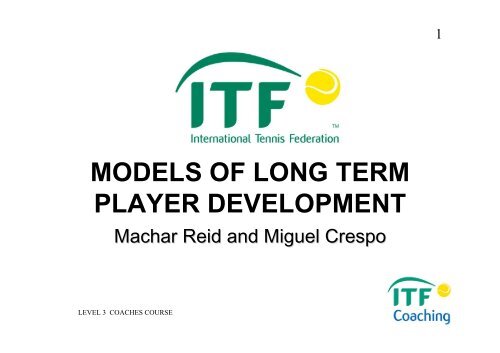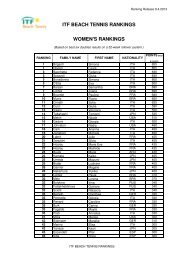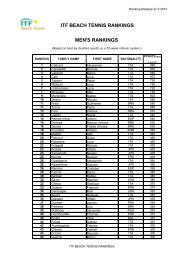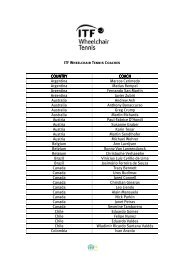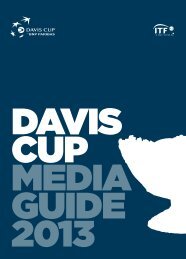MODELS OF LONG TERM PLAYER DEVELOPMENT
MODELS OF LONG TERM PLAYER DEVELOPMENT - ITF
MODELS OF LONG TERM PLAYER DEVELOPMENT - ITF
- No tags were found...
You also want an ePaper? Increase the reach of your titles
YUMPU automatically turns print PDFs into web optimized ePapers that Google loves.
1<br />
<strong>MODELS</strong> <strong>OF</strong> <strong>LONG</strong> <strong>TERM</strong><br />
<strong>PLAYER</strong> <strong>DEVELOPMENT</strong><br />
Machar Reid and Miguel Crespo<br />
LEVEL 3 COACHES COURSE
SPECIALISATION <strong>OF</strong><br />
2<br />
TRAINING<br />
SPORTS<br />
EARLY SPECIALISATION<br />
LATE SPECIALISATION<br />
Require early sport-specific<br />
specialisation in training.<br />
Require a generalised approach to early training<br />
(i.e. in tennis, emphasis on developing/ mastering<br />
fundamental motor and perceptual motor skills<br />
such as running, throwing and catching.)<br />
Gymnastics, figure skating and diving<br />
Tennis, hockey, athletics<br />
LEVEL 3 COACHES COURSE<br />
(Balyi and Hamilton, 1999).
MAKING IT TO THE TOP<br />
3<br />
8-12 years of training for a talented<br />
athlete to reach elite levels (Bloom, 1985;<br />
Ericsson and Charness, 1994).<br />
10 YEAR or 10,000 HOUR (slightly<br />
more than 3 hours of practice daily for<br />
10 years) RULE (Salmela, 1998).<br />
In tennis, specialisation is not<br />
recommended prior to age 10 if early<br />
burn out/ drop out/ retirement is to be<br />
avoided (Balyi, 1999 and 2001 a; Harsanyi, 1983).<br />
LEVEL 3 COACHES COURSE
4<br />
<strong>MODELS</strong> <strong>OF</strong><br />
TRAINING/<strong>DEVELOPMENT</strong><br />
EARLY SPECIALISATION MODEL<br />
LATE SPECIALISATION MODEL<br />
1. Training to Train<br />
2. Training to Compete<br />
3. Training to Win<br />
4. Retirement<br />
1. FUNdamental<br />
2. Learning to Train<br />
3. Training to Train<br />
4. Training to Compete<br />
5. Training to Win<br />
6. Retirement<br />
LEVEL 3 COACHES COURSE
Training up to ≈ 12<br />
5<br />
STAGES<br />
STRENGTH/<br />
POWER<br />
COMPONENTS <strong>OF</strong> NEUROMUSCULAR FITNESS<br />
SPEED<br />
AEROBIC<br />
ENDURANCE<br />
CO-<br />
ORDINATION<br />
FLEXIBILITY<br />
FUN-damental<br />
M – 6-9 years<br />
F – 6-8 years<br />
Learning to<br />
Train<br />
motor coord.<br />
BW exercises<br />
(to relative<br />
strength)<br />
First<br />
window;<br />
challenge<br />
CNS (
Training players aged ≈ 12 -16 years 6<br />
PHYSIOLOGY<br />
<strong>DEVELOPMENT</strong> <strong>OF</strong> AEROBIC ENDURANCE (AE)<br />
> 12 years = good improvements in VO2 max; < 12 = improved movement economy<br />
largely responsible for AE.<br />
> 12 years = gender differences in AE, as girls have lower absolute and relative amount<br />
of lean tissue and greater accumulation of body fat.<br />
TRAINING<br />
• Session = 30-45 minutes (HR 130 -160bpm) + warm-up and cool down.<br />
• Non-weight bearing aerobic activities help to prevent overuse injuries, such as Osgood-<br />
Schlatter disease.<br />
• Cross training (i.e. soccer, touch rugby, water polo, frisbee...) to specifically stress the<br />
aerobic system.<br />
LEVEL 3 COACHES COURSE
Training players aged ≈ 12 -16 years 7<br />
PHYSIOLOGY<br />
<strong>DEVELOPMENT</strong> <strong>OF</strong> ANAEROBIC ENDURANCE (AAE)<br />
• Trainability of AAE in players < 14 is limited.<br />
• Low rates of glycogen utilisation and decreased intra-muscular glycogen<br />
concentrations.<br />
• 14/U players unable to tolerate blood and muscle lactate concentrations that are as<br />
high.<br />
TRAINING<br />
• >14 years, AAE training would be performed at a near maximal intensity (work:rest<br />
ratios ≈ 1:4).<br />
• On-court no more than 8 strokes played/set (i.e. lactate < 8-10mmol/l) to maintain<br />
coordinative performance.<br />
LEVEL 3 COACHES COURSE
Training players aged ≈ 12 -16 years 8<br />
<strong>DEVELOPMENT</strong> <strong>OF</strong> SPEED<br />
Second speed window is 11–12 years (females) and 13-16 years (males) (Viru, 1995; Viru et<br />
al., 1998).<br />
Introduction of anaerobic alactic power and anaerobic alactic capacity interval training<br />
all year round (i.e. at end of warm-ups) will not interfere with development objectives.<br />
Linear and multi directional movement speed should be trained both on-court and offcourt.<br />
TRAINING<br />
QUALITY<br />
WORK REST INTENSITY<br />
MODE<br />
ALACTIC POWER<br />
Isolated or combined<br />
speed-plyo drills<br />
1-5 seconds 2-3 minutes<br />
Maximal<br />
ALACTIC CAPACITY<br />
As for Alactic Power<br />
but longer duration,<br />
greater amplitudes.<br />
< 10 seconds 2-3 minutes<br />
Maximal<br />
LEVEL 3 COACHES COURSE
Training players aged ≈ 12 -16 years 9<br />
STRENGTH/POWER TRANING<br />
Benefits (when planned in a controlled and safe manner)<br />
• Significantly increase muscular strength, increase local muscular endurance, improve posture, prevent injury and<br />
enhance sports performance (Kraemer, W.J. & Fleck, S.J., 1993).<br />
Guidelines<br />
• Onset of Peak Height Velocity (PHV) = extent and frequency of weight training.<br />
• Critical periods for accelerated adaptation:<br />
• Females - toward end and immediately after PHV<br />
• Males - 12 – 18 months after PHV<br />
• Players should master the basic lifting techniques during the PHV phase. Peak Weight Velocity (PWV) or body<br />
mass gain will occur after PHV.<br />
Exercise focus:<br />
• Free weight (with onset of PHV) and bodyweight exercise<br />
• Further enhance level of muscle coordination.<br />
• Specific conditioning exercises to minimise any potential muscular imbalance and injury risk<br />
• General prehabiliatation exercises (including joint proprioceptive work, “core” stability, …)<br />
Frequency:<br />
Two or three times sessions/week ≈ 30 minutes need to be performed.<br />
LEVEL 3 COACHES COURSE
Training players aged ≈ 12 -16 years 10<br />
Rapid growth of<br />
athletes during<br />
adolescence<br />
CONTINUING TO IMPROVE COORDINATION<br />
CHANGES in or<br />
temporarily<br />
REGRESSION of<br />
Centre of gravity,<br />
trunk and limb length/girth,<br />
movement skills and,<br />
technical skills<br />
LEVEL 3 COACHES COURSE<br />
Patience required from<br />
coach; movement/technical<br />
skills may need to be<br />
revisited
Training players aged ≈ 12 -16 years 11<br />
FLEXIBILITY<br />
• Needs to be monitored carefully.<br />
• Static stretching to form foundation of developmental flexibility<br />
training programme.<br />
• Scheduling of separate stretching sessions is recommended.<br />
• Dynamic mobility and prehabilitation routines should replace static<br />
stretching in warm-ups.<br />
LEVEL 3 COACHES COURSE
Training players aged ≈ 12 -16 years 12<br />
OTHER CONSIDERATIONS<br />
Training to Competition Ratio<br />
• Generally 60:40 (including competition specific training) is recommended (Balyi and Hamilton,<br />
1999a; Bompa, 1995).<br />
Recovery<br />
• Specific recovery sessions are necesary (i.e. cool down, hydration and nutrition,<br />
massage, hydrotherapy, passive rest, …)<br />
Long-term development<br />
• Forms the critical or sensitive period of physical and skill development.<br />
• Overemphasis on competition instead of on training can limit potential, irrespective of<br />
subsequent remedial action (SportMap, 2001).<br />
LEVEL 3 COACHES COURSE
16 AND BEYOND<br />
13<br />
STAGE<br />
Training to<br />
Compete<br />
M – 16-18 yrs<br />
F – 15-17 yrs<br />
Training to<br />
Win<br />
M –18+ yrs<br />
F – 17+ yrs<br />
Retirement<br />
CHARACTERISTICS <strong>OF</strong> YEAR-ROUND, TENNIS- AND<br />
INDIVIDUAL-SPECIFIC PHYSICAL TRAINING<br />
Reliable and valid fitness testing essential<br />
More specific to game style, which will be more clearly defined<br />
Periodisation will reflect short- and long-term objectives<br />
Block loading – training emphasis on one quality/capacity while<br />
others maintained – useful.<br />
Periodisation difficult; block loading may be used; programmes<br />
may be surface-specific<br />
Emphasis on maintenance (strength ≈ 1 session/7-10 days;<br />
endurance ≈ 2 sessions/7 days; …) and recovery during<br />
tournaments<br />
Transition into other career post-sport<br />
TRAINING<br />
TO COMP.<br />
RATIO<br />
40:60<br />
25:75<br />
LEVEL 3 COACHES COURSE


